Ask any manager about how they spent their day, and they’ll probably immediately dig into the weeds — rattling off a long list of 1:1 meetings, putting out fires, responding to Slack messages or writing up strategy docs to send up the ladder to the higher-ups. At a fast-paced startup, with more tasks than people to accomplish them, managers are often still filling in individual contributor-sized gaps while simultaneously stretching into director-shaped roles.
But what we’ve found is that the most high-impact managers make a regular habit of setting aside moments of reflection, putting in the deliberate time and work it takes to gain a new perspective on their teams, their cross-functional relationships and their own effectiveness from a higher altitude.
It got us thinking — there’s certainly plenty of content on the questions managers should be asking others, whether it’s questions to ask in a 1:1 with a direct report, questions to ask candidates in interviews, or questions to ask their own managers to make the delicate art of managing up a bit easier. But there’s not nearly as much advice on the questions managers should be asking themselves during critical moments of reflection.
An example of what we mean comes from Rick Song, CEO of Persona, who introduced us to the pre-mortems exercise: the act of thinking through why a particular strategy, product idea, or candidate might not work out down the line. He leans on one question over and over again, whether he’s considering hiring a new candidate, taking on a new project, or setting plans for the quarter: “Why might this not work?”
To find other equally impactful questions, we reached out to managers and leaders all across the First Round community for their take on this prompt:
What are the questions managers should ask themselves on a regular basis?
We received a heap of thought-provoking responses in return, from questions focused on team morale, like “How many of my team’s successes have I celebrated recently?” and “Are we doing this with joy?” to situational questions like “How would I tackle this problem if I was in my team member’s place?” or “Am I personally modeling the behavior that I want to be true?”
We assembled a list of 35 questions for managers to ask themselves, covering everything from assessing their team’s performance, to managing up and cross-functionally and performing a self-check-up on their own wellbeing. Some will be questions you may find yourself asking regularly, even several times a week. Others may only crop up when you’re staring down a particularly sticky decision or annual performance reviews. Some are short and sweet, while others require a bit more context to unpack the true power of the inquiry.
Our suggestion to start building this habit of reflection? Try setting aside 15 minutes on your calendar each week, and run through just a few of the questions on this list. We’ve gathered all of them (and all the relevant follow-up questions) here in this Notion document organized by cadence so it’s easy for you to refer back to them time and time again. We hope that in adding this exercise to your managerial hygiene, you’ll uncover some new truths and level up your leadership.
QUESTIONS FOR GAUGING TEAM MORALE
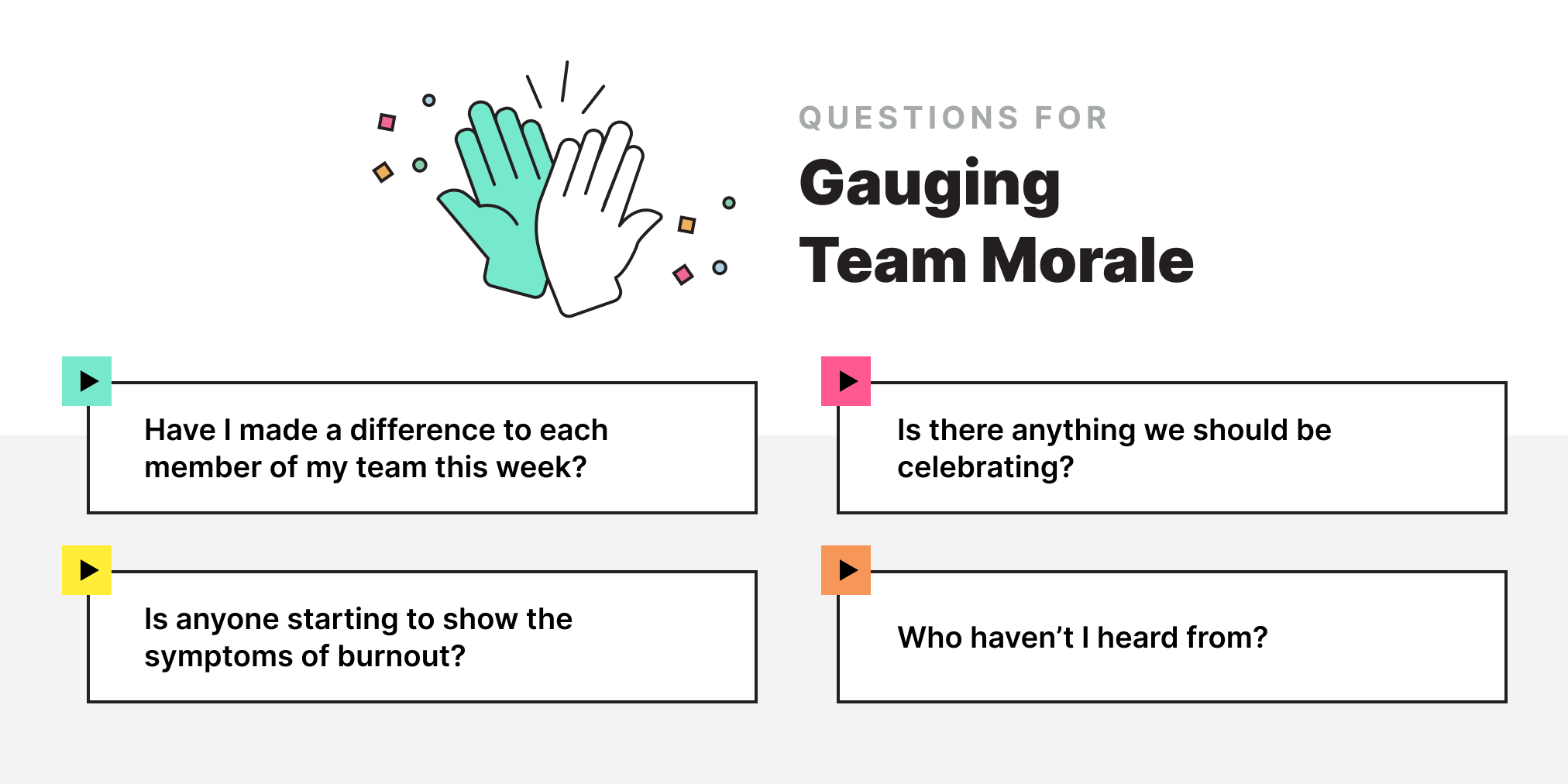
As a manager, keeping a finger on the pulse of your team is one of the most important pieces of the job. But folks don’t always feel comfortable being completely honest when they’re not motivated or are struggling with burnout. Your job as a manager is to carefully tune your ears for what’s not being said, as much as what’s been vocalized. Use these questions to listen for the whispers as well as the shouts.
1. Who haven’t I heard from?
As Molly Graham points out, often managers won’t hear much from their highest performers, who are heads-down building and cranking out results, which is why her advice strikes a somewhat counterintuitive chord. “It's really easy to think, ‘That person is so strong, they just take care of themselves. I'll go focus on the rest of my team.’ But I firmly believe that the majority of my time and coaching energy should actually go into people who are high-performing. They are the rocket ships that could end up running parts of the company someday.”
Along those lines, Matt Wallaert, Head of Behavioral Science at frog, tries to avoid common traps. “My approach to management is about fighting cognitive biases. Humans have a recency bias, meaning we tend to overweight recent experiences. In management that means I’m mostly paying attention to whoever I talked to last — as the saying goes, ‘The squeaky wheel gets the grease.’ So I try to be on alert for the people who I haven’t heard from,” he says. “It’s often because they are deep in the thick of something and could use support — but aren’t asking for it. Sometimes folks are quiet because they’re chugging right along — and I want to celebrate that with them.”
Not everyone is going to be a squeaky wheel. As a manager, you need to be listening for what you’re not hearing as well.
Try implementing this tactical idea from Ximena Vengoechea, author and user research expert: “I love using Rose, Bud, and Thorn updates in small team meetings — sharing one highlight, one new idea you’re excited about, and one challenge. This helps to get past the surface-level stuff. I’ve found that people really do share what feels ‘thorny’ to them and we were able to have deeper, more intentional team conversations as a result,” she says.
2. How well do I know my team members? How well do they know each other?
“To have a good working relationship with your team, it's paramount that you know them personally. What are their passions outside of work, who are the important people in their family, what challenges have they faced in their lives, what experiences are they the proudest of, what are their long-term career aspirations?” says Anita Hossain Choudhry, CEO of The Grand. “As a manager, it's also your responsibility to make sure your team is able to feel a sense of belonging and build relationships with each other, especially in a remote environment. Research shows that when employees feel like they belong, they perform 56% better at their jobs.”

She suggests a few simple ways to get to know each other better as a team:
- RYG Check-in. “During our weekly team meetings, we do a simple red, yellow, green check-in. It's a stoplight analogy to share how you really are in this moment. Green means we are here and we are present. Yellow means that we are here, but maybe our head is somewhere else — a deadline we have, or a conversation that's lingering. Red means that we are here physically, but our minds are completely elsewhere. It's important to note that there is no one check-in or color that's better than the others. The goal of this exercise is to be honest with ourselves and with each other about how we're arriving to this space.”
- Start with a question. “Along with the check-in, we also ask a question that allows us to learn more about each other. An example of a question might be: What is the origin of your first name? Or, what did you want to be when you grew up? This unlocks really interesting facts and stories about each other that might not come up in day-to-day conversation.”
- Host regular Fikas. “Fikas are coffee breaks in Swedish culture and a time to enjoy a snack and get to know each other better. On our team, the host rotates and they plan the Fika break for the rest of the team. We've done book club chats, played a game, had show-and-tell, and more.”
- Add it to your offsite agenda. “One activity we did at our offsite was called ‘10 pictures.’ Everyone shared 10 pictures throughout their life and had 5 minutes to tell the stories behind the photos. It was an amazing way for the team to get to know where people are coming from and what led them to become who they are today.”
3. Have I made a difference to each member of my team this week?
Monty Fowler, Senior Manager of Revenue Enablement for Lob, leans on this question weekly.
Elaine Martel-Walker, Senior Director of Account Management for Cricket Health, also gives herself a quickly weekly grade by asking “Have I checked in with each employee this week to see how they’re doing?” which is particularly apt over the tumult of the last couple of years.
4. Have I expressed gratitude to every single person on my team recently?
Laura Del Beccaro, co-founder and CEO of Sora, puts this into practice with a recurring monthly to-do on her calendar to send an email or Slack note to at least a few folks expressing a recent highlight and why she’s grateful to have them on the team. (She’s also got a ton more lessons on thoughtfully approaching startup culture from the earliest days.)
“It’s a valuable exercise to think about who I couldn’t live without or even who I might be taking for granted,” she says. “It’s important to take a step back from the hectic day-to-day and recognize the hard work that goes into a startup.” As she kept up with this monthly calendar to-do, Del Beccaro found it became easier for her to spot opportunities to express gratitude in the moment.
It’s a practice that also serves as a brief gut check where folks might need some feedback, rather than saving it up for a pre-scheduled performance review. “If there’s someone for whom I struggle to find much to say, there are likely some performance issues and I need to deliver feedback, if I’m not doing so already,” she says.
5. Is anyone a flight risk?
“It’s important to love your job, feel appreciated and like an integral part of a team. There are a lot of job opportunities out there for folks, so I try to give my team plenty of reasons to stay. Carve out the time to step back regularly and see the bigger picture of how someone might be feeling about their place on the team and at your company,” says Jenna Klebanoff, VP of Marketing at realtor.com.
Range co-founder and CEO Daniel Pupius adds these questions to dig deeper into whether someone might be feeling overwhelmed (or underwhelmed):
- Is anyone starting to show symptoms of burnout?
- Does workload need to be rebalanced? What should we stop doing?
- Does anyone need more of a challenge?
Similarly, Padmini Pyapali, Engineering Manager of Uniswap, uses a simple barometer to look for clues that someone’s headed towards burnout: “Are folks engaged during team meetings? Is there good collaboration in Slack channels?”
QUESTIONS FOR TRACKING TEAM PERFORMANCE
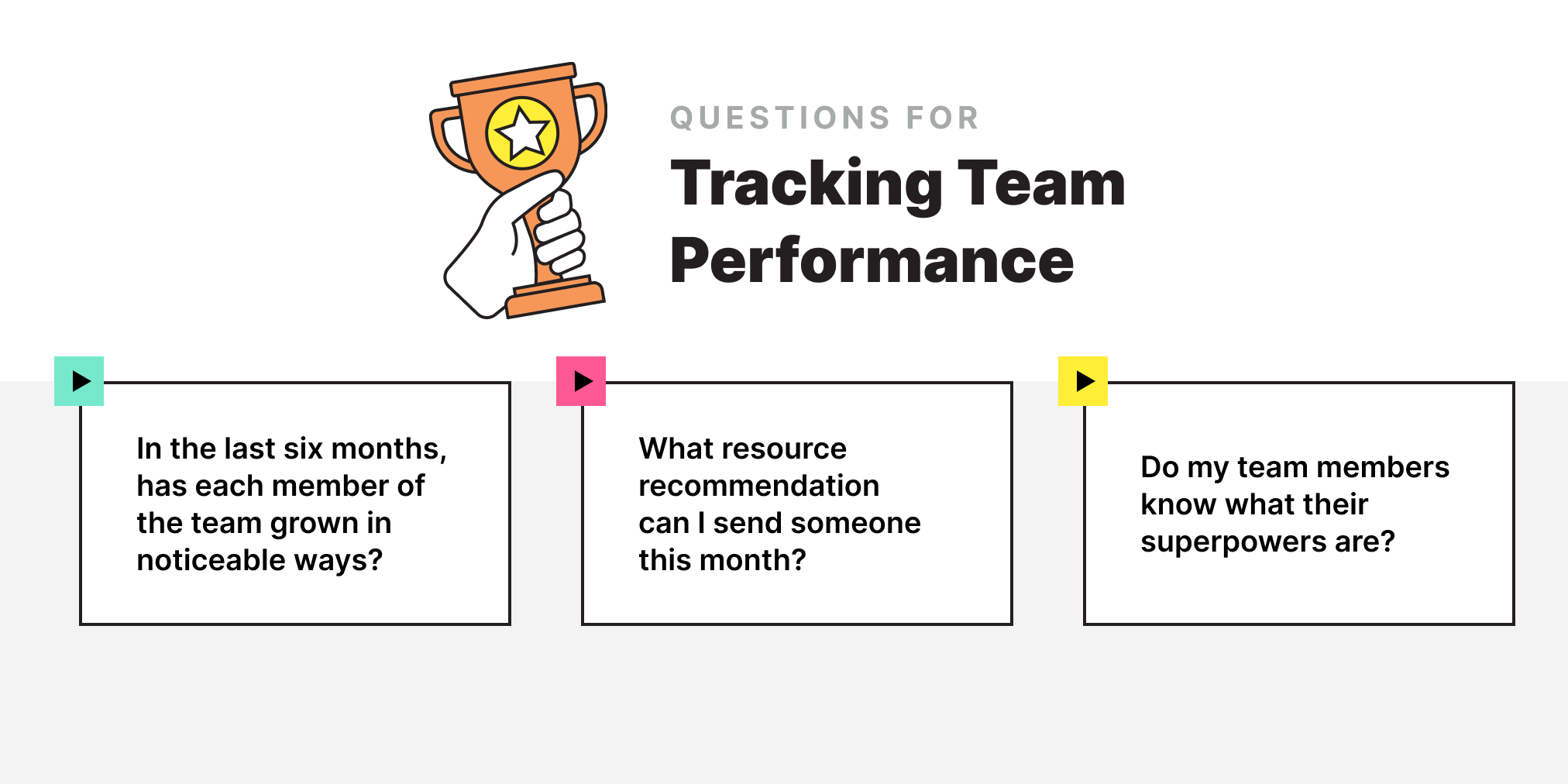
As a team, there are goals you’re working towards together, like KPIs to hit or new features to ship. In the midst of a startup’s day-to-day chaos on the quest to meeting those goals, it can be easy to forget the individuals who make up that team — each with their own career aspirations, strengths and weaknesses. Use these questions to make sure you’re not applying a one-size-fits-all approach to performance management.
6. Is each member on the team overperforming, on track or underperforming?
“For the over-performers, I'll look for ways to further enable them. Are there roadblocks I can clear or additional runway I can provide?” says Ravi Mehta, co-founder and CEO of Scale Higher.

“For the under-performers, it's important to figure out the root cause. Often, under-performance is not because of a lack of capability to succeed, but a lack of opportunity. In other words, limited resources, unclear goals, or disempowerment might be holding them back,” says Mehta. That’s why these questions for managers are key:
- How can I make sure the person has the fullest opportunity to succeed?
- What capabilities do they need to take advantage of that opportunity?
While these thought-starters aren’t a replacement for an official performance review, this quick audit is an opportunity to make this reflection a more regular habit — not just something to consider when performance review season rolls around.
To assess beyond the current state and instead cast into the future, Melissa Nightingale, co-founder of Raw Signal Group, asks herself: “What would it look like if every person on my team were thriving in their role?”
“I use this question as a jumping-off point for surfacing latent feedback and spotting mentorship, coaching or sponsorship opportunities,” says Nightingale.
Startups change so rapidly — often the skills someone needed when they were hired shift as the business grows or pivots. As a boss, it’s our job to ensure our people are working with a modern toolkit that’s keeping pace with what the company needs.
7. What resource recommendation can I send someone this month?
“In order to keep myself focused on my team member’s professional growth, I aim to send them one article, podcast or book recommendation every month related to things they are interested in — whether that be their current role or aspirational role. It’s been a great tool for opening up dialogues on various topics that we may not get to otherwise,” says Colleen McCreary, Chief People Officer of Credit Karma.
8. Does my team know what success looks like for their role?
“A common mistake I find managers make is that they assume their team is clear on the goals and what’s expected of them without bothering to check with their teams. This question helps identify potential areas of misalignment early on and sets clear expectations to ensure everyone can thrive and achieve their goals,” says Shivani Berry, founder and CEO of Ascend.

Mindy Zhang, executive coach at Throughline and The Grand, conducts a quarterly Team Audit to ensure her team is set up for success. “At a fast-growing company, managers can slip into playing whack-a-mole with their direct reports' problems. A team member brings up a challenge, and we try to spot-fix it as quickly as possible. This approach might feel satisfying in the moment, but it's incredibly inefficient, especially as your team grows,” says Zhang.
In treating one-off symptoms, you miss out on identifying the root causes that hold your team back from doing their best work.
For each direct report, she gets more specific by following these prompts and jotting down her responses:
- What does success for this person look like in the next quarter? This includes both OKRs and career development goals, like ramping up on a new skill.
- To what extent are they equipped for success? You can grade this red/yellow/green. Red means there are major risks in their ability to be successful— for example, flight risk, burnout risk, performance risk, or severe lack of resources to do their job well. Yellow means there are medium risks— for example, maybe they're taking on a stretch project for the first time and don't have the skill set. Green means they are solid and have what they need to be successful.
- What does this person need to be equipped for success?
- What specific actions can I and/or others take to support them?
- What motivates this person, and how can I give them more of this?
- What’s one growth area that would take their careers to the next level? How can I better support them in this?
“By running through these questions quarterly, I often realize I have some blindspots. I’ll then set up an hour-long 1:1 with each team member and ask them these same questions to round out my understanding as a manager,” says Zhang. (For more here, check out her advice on how to become a coaching manager, not just a fixing manager.)
9. Does my vision for the team member’s trajectory line up with their vision for their own career trajectory?
“We may think we know what our team members want from their careers, but are we really sure we have it right? One tactic I've seen to help de-risk this gap forming and growing is independently writing talent plans and then coming together with your report to see what you have in common and what doesn't quite line up. That's a great place to start the conversation about how to get your team members where they want to go,” says Brie Wolfson, a former Stripe and Figma leader who’s advising and writing for founders at The Kool-Aid Factory.
Kintan Brahmbhatt, former GM of Podcasts for Amazon, suggests this similar question at a more granular level: “Is my team member getting closer to their long-term aspirations by working on this project and team?”

10. In the last six months, has each member of the team grown in noticeable ways?
Amanda Schwartz Ramirez, the founder of Garden Labs, includes these follow-up questions when managers aren’t able to clearly spot growth in their direct reports.
- In what ways can I accelerate their growth and learning?
- As a manager, what 1-2 things am I doing that are preventing my team from doing their best work?
11. If I could just wave a magic wand and have a new candidate replace this position, would I want to do it?
During Sora’s bi-annual performance reviews, CEO Laura Del Beccaro starts with this simple framing that may uncover the need for a tough conversation.
- If the answer is yes, what about a new candidate would make me want to make the switch? These traits and competencies should then be brought up in the performance review.
- Does the idea of replacing this person give me any feeling of relief, like we would be better off? Put the opposite way — would I hire this person again in a heartbeat? Answers to these questions help me think about whether we should start to have tough conversations about this person moving on.
12. Does my team know what their superpowers are?
“Oftentimes, superpowers can go undetected by those who have them, because it makes things feel easy or natural. True career success will come from playing to those strengths,” says Brie Wolfson. (For more here, check out her article on the essential documents for honing in on your superpower.)
Tell your team members where they spike — they may not know.
Put another way, The Grand’s Anita Hossain Choudhry asks herself: “When was the last time I gave reinforcing feedback?”
“There are plenty of resources on how to give developmental feedback. However, we often forget to share positive, reinforcing feedback with our direct reports because it feels optional. That's not the case. When we're able to effectively share reinforcing feedback we can help our team members know what they're doing well, what the expectations of their work are and how they can continue to exhibit that positive behavior,” she says.
To make sure the reinforcing feedback stands out, it’s important to get very specific. “For example, if they nailed a sales call, instead of saying ‘Great job’ you can try something like, ‘Nice job on that call! I noticed that you built strong rapport with the client, made them feel heard, and diffused their concerns about the product.’ Now they have a better sense of what's working and what they can double down on in the future,” says Hossain Choudhry.
13. What are the challenges ahead of our team?
“Every team faces a long list of difficult, sometimes insurmountable challenges. I like starting each quarter by listing these challenges with the team. Then a quarter later, compare the list to the previous quarter. The list never gets shorter, but we know we're making progress when previous challenges are replaced with new ones. If we don't consistently remove our biggest obstacles — well, we're not making progress,” says Nikhyl Singhal, VP of Product at Meta.

QUESTIONS FOR MEASURING YOUR EFFECTIVENESS AS A MANAGER
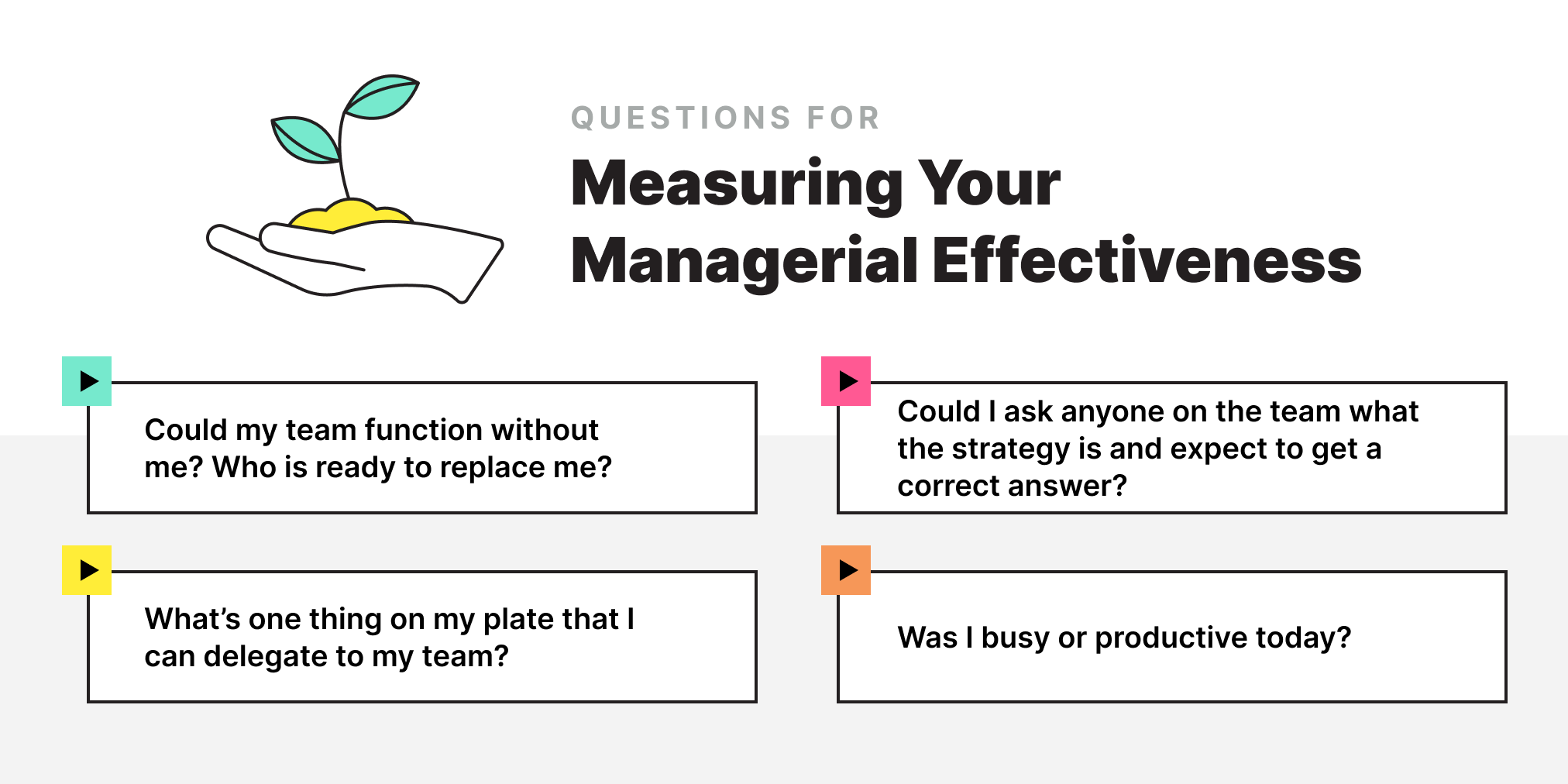
Aside from the occasional 360-review, it can be tricky to gauge how you’re performing as a manager. As your team grows, the less tactical your work becomes — and the harder it is to measure your own performance with traditional metrics. These questions test some of the squishier factors that go into effective management.
14. Does the team know what the strategy is (not just our tactics)?
Along with the above, Daphra Holder, Product Lead at Meta, also suggests this follow-up question: “Could I ask anyone on the team about the strategy and expect to get a correct answer?” And to prevent getting stuck in tactical mode: “Am I giving the team enough oxygen to think big, not just execute?”
Wes Kao, co-founder of Maven, agrees that strategic thinking is a critical skill to foster across the team — not just for managers. “My management style is built around what I call rigorous thinking, which is having a systematic way of making decisions. Most talented people get to positions of leadership because they’re killer at strategy and execution. But to be a successful manager, you can’t just rely on doing it all yourself.”
You have to teach your team to think strategically. If you only accept or reject their ideas, your team never learns how to improve their judgment.
“Rigorous thinking shifts the dynamic from a one-sided decision to a two-way scenario planning session where any idea goes. This encourages direct reports to consider all the variables the manager usually considers, including second-order effects, what success looks like, and more. Under rigorous thinking, direct reports become sharper thinkers through practice while managers deliver stronger results and outcomes,” says Kao.

15. Is anyone on the team just cranking out work without context?
“Without the business context on why you're doing the tasks you're doing, you're just not going to be as motivated or excited. I want to ensure that my team knows and believes that every single thing they are doing is driving value for the business,” says Jenna Klebanoff. “So I do my best to invite them to the meetings when possible, and when it's not possible, give the context on why we're doing this and how it supports the business goals. This also puts them in a position to challenge any projects that come along that aren't driving business goals, which is empowering for the employee.”
Anita Hossain Choudhry likes to position the question this way: “What am I not saying that needs to be said?”
“Sometimes as managers, we get in our heads and don’t share the challenges we’re facing and what we’re really thinking. This question allows me to better understand what context the team might be missing and also reflect on what’s keeping me up at night and how I might bring the team in to help me think through solutions,” she says.
16. What more can I say no to?
“I learned about JOMO (the joy of missing out) and try to practice saying no to more so that I can be more present for my team and my work. It’s tricky to do in practice, so I ask myself regularly what I can turn down or take off my plate,” says Tomika Anderson, Principal at Riviera Partners.
If you’re having a hard time finding your own JOMO, consider this framing from Laura Rubin, founder of Nurture: “What are the true priorities versus the nice-to-haves?” Or this question from Padmini Pyapali: “Are there any tasks we’re working on that aren’t worth the cost?”
17. Could my team function without me?
“This, in some ways, is the hardest pill for a manager to swallow — but it’s an important one. If you’re running a healthy team, they should be able to thrive without you. As the founder of Patagonia famously said, ‘People know, if the warehouse burns down, don’t call me. What can I do? You know what to do,’” says Brie Wolfson.
Adding another layer, Credit Karma’s Colleen McCreary suggests this question: “Who is ready to replace me?”
“I’m constantly thinking about who is ready to replace me and where the gaps are. It’s not because I’m planning to leave, but it forces me to think deeply about the strengths I’m trying to develop, how to coach better business relationships, or who needs new exposure and opportunities,” she says.

18. What’s one thing on my plate that I can delegate to my team?
“I have a habit of trying to do it all instead of delegating. I justify it by telling myself that it’s either faster if I just do it, or I don’t want to add more work for my team. But delegating actually empowers the team and frees me up to focus on high-impact tasks that only I can take on,” says Shivani Berry.
I have to constantly remind myself: When I don’t delegate, I take away an opportunity for my team to grow.
If there’s anything on your own plate that seems to be consistently getting pushed off and de-prioritized, that’s a nudge to consider letting someone else on your team run with it, says Laura Del Beccaro.
Massella Dukuly, Director of Team Enablement for LifeLabs Learning, adds this one: “Have I asked for help lately?”
“It can be really easy to jump at every task — simply because we know that we can do it and also because we believe if we do it, we'll do it faster. This is a common leadership fallacy. In reality, our time and energy is best spent on specific tasks and strategic thinking. Lack of delegation and an inability to understand where you truly add the most value can derail meaningful growth opportunities for your team, cause unnecessary burnout and stress, and ultimately impact how well your company scales,” says Dukuly. (For more on the small management habits that make an outsized difference, check out this article from Dukuly and the LifeLabs Learning team.)
19. When was the last time I asked for feedback?
Sara Rosso, Director of Product Marketing at HubSpot, suggests the above for keeping lines of communication open between you and your team.
We like this one because there’s a lot of advice out there on how to artfully give feedback to others, but not so much on how to attract useful feedback about ourselves. (If you find that you’re not getting a steady stream of feedback, this guide from Shivani Berry offers practical pointers for becoming a feedback magnet.)

Brett Wienke, VP of Global Sales Development for Lattice, likes to position it this way: “Do I know what my perceived gaps are?”
“It’s critically important to understand not only what you’ve self-identified as skill gaps, but also what your reports, partners and leadership team view as your skill gaps. Working knowledge of perceived gaps allows for positive, constructive dialogues and can advance meaningful work on closing those gaps,” he says.
20. How many times did I ask questions versus give answers this week?
“As managers, we often default to fixing our direct reports' problems versus coaching them to find their own solution. Unfortunately, that's not always the best route because we might not have full context or expertise in a situation and we might also create a dependency to give answers. That's why it's important to do a gut check and gauge how much we were in fix-it mode versus listening empathetically and asking open and honest questions,” says Anita Hossain Choudhry.
Think back to your last 1:1. How much were you speaking and how much was your report speaking?
QUESTIONS FOR BETTER DECISION-MAKING
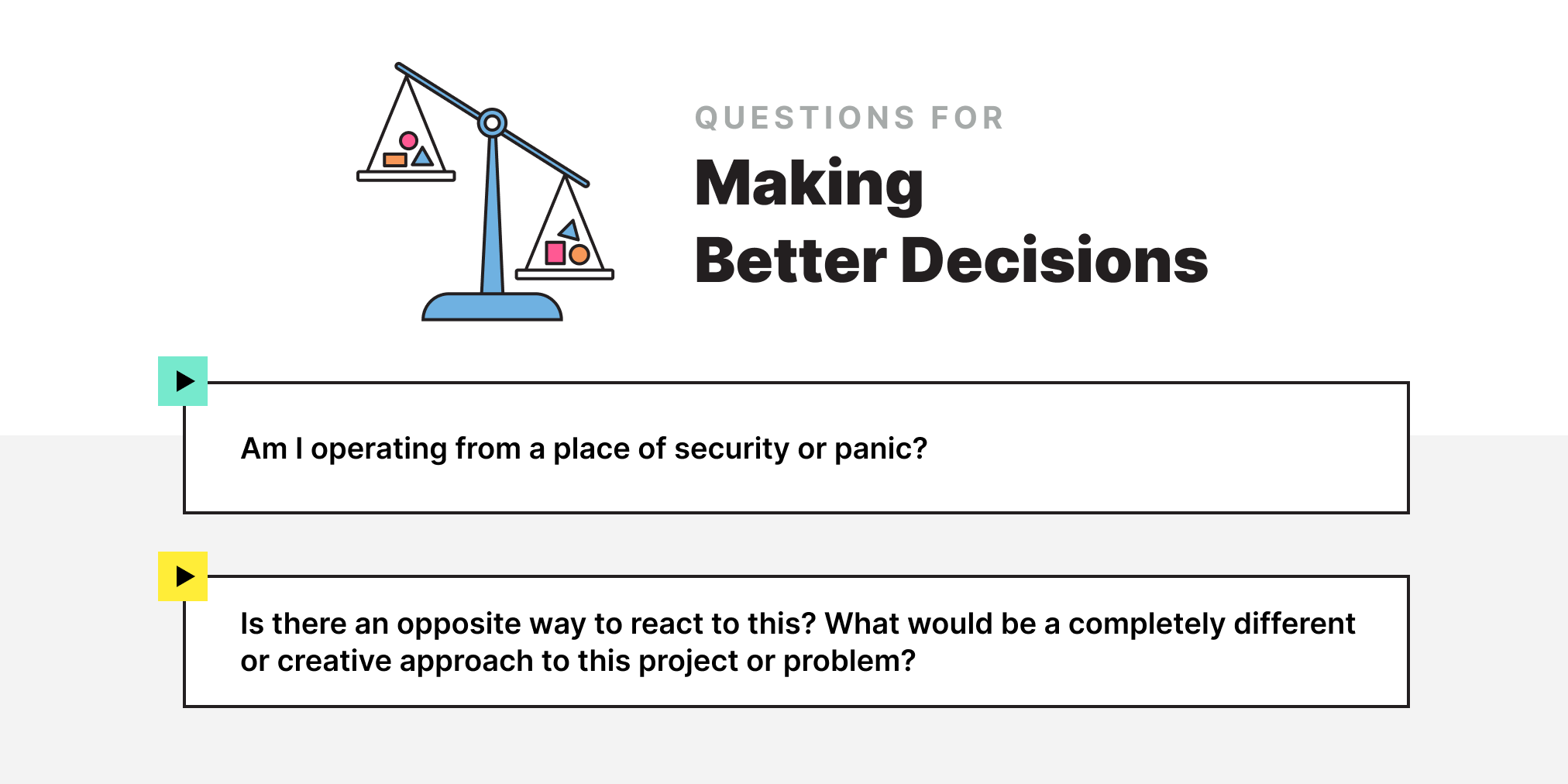
When operating at a startup, there’s often a credo to experiment fast and fail fast. But that doesn’t mean rushing the decision-making process — otherwise, you could end up sinking months into a project with a flawed premise. Use these questions to carefully outline the key inflection points and factors in the big-ticket decisions you face as a manager.
21. How sure am I?
“As a leader, my role is to set a clear vision, drive alignment on shared objectives, be the steward of the team's culture and implement mechanisms to achieve those shared goals. I measure myself through input and output metrics along two dimensions — my impact on my team members’ growth, and my impact on the team’s shared objectives,” says ex-Amazon leader Kintan Brahmbhatt. When he faces a particularly thorny decision or wide-sweeping strategic shift, Brahmbhatt runs through these questions:
- Why now?
- Is this a reversible or an irreversible decision?
- If irreversible, what makes it so? Can I break it down into multiple smaller decisions, some of which may be reversible?
- What factors won’t change in 10 years? How much of our plan is optimizing for durable traits versus betting on new trends and traits that will change?
- How do we know we are succeeding in our goal?
- What are the top controllable factors that impact the outcome of this decision? Have I focused on them appropriately?
- What are the top uncontrollable factors? How am I mitigating their risk?
- What is the worst-case scenario? What concrete steps can we take to ensure that the worst-case scenario does not happen? What steps can we take to rebuild, should we hit the worst-case scenario?
- What decision would the CEO of the company most likely make if they were in my shoes?
22. Am I operating from a place of security or panic?
“My ideas, approach and judgment will be impacted depending on where my mindset is in that moment. So in moments of important decision-making, I try to check in on my mindset with which I’m approaching the problem,” says Shreya Iyer, former Senior Director of Talent Acquisition for Splunk.
She also suggests this related question: “Is there an opposite way to react to this?”
“In moments of important decision making, I take the role of devil's advocate and argue against myself. This helps me round out my thinking more holistically,” says Iyer. “I also challenge my reports to do this in 1:1s to help them get used to challenging their own beliefs. I also do this in our team meetings where I rotate the role of devil's advocate across my reports. This allows them to identify similarity bias, get comfortable with respectfully disagreeing with colleagues and helps them build the muscle for challenging their own beliefs.” (Iyer covered this idea of rotating devil’s advocate in her article on career development.)
Borrow this practical tip to stay grounded in your daily routine: “When I have to go into a meeting where I'm a part of important decision making, I often put 5 minutes on my calendar before that meeting where I remind myself to ask these questions,” she says.
23. What would be a completely different approach to this answer, project or problem?
Iyer also suggests questioning the premise. “We often treat the premise as one that cannot be questioned or changed. When I'm up against a challenge, it’s helpful to question the premise and, in turn, my own assumptions and concessions. When I realize there is space to negate the premise, it opens up multiple channels for solution building or creative thinking,” she says.
When it comes to startups, Hubspot’s Sara Rosso suggests putting a premium on speed and creativity: “Is there a faster or more agile way to get the results we desire? Is there a creative alternative?”
24. Am I hearing the group’s problems?
As a seasoned user research leader, Ximena Vengoechea listens for a living (check out her advice on how all kinds of folks can become better listeners). So when she’s facing a decision-making juncture, she tries to listen for the problem that’s surfacing, even if it’s not being explicitly said. “I try to understand how my stress, bias and emotion might be getting in the way of understanding what my team needs.”
And when a decision is reached, she adds an important question to close the loop: “Am I communicating my plans and intentions with clarity?”

QUESTIONS FOR MANAGING UP & SIDEWAYS
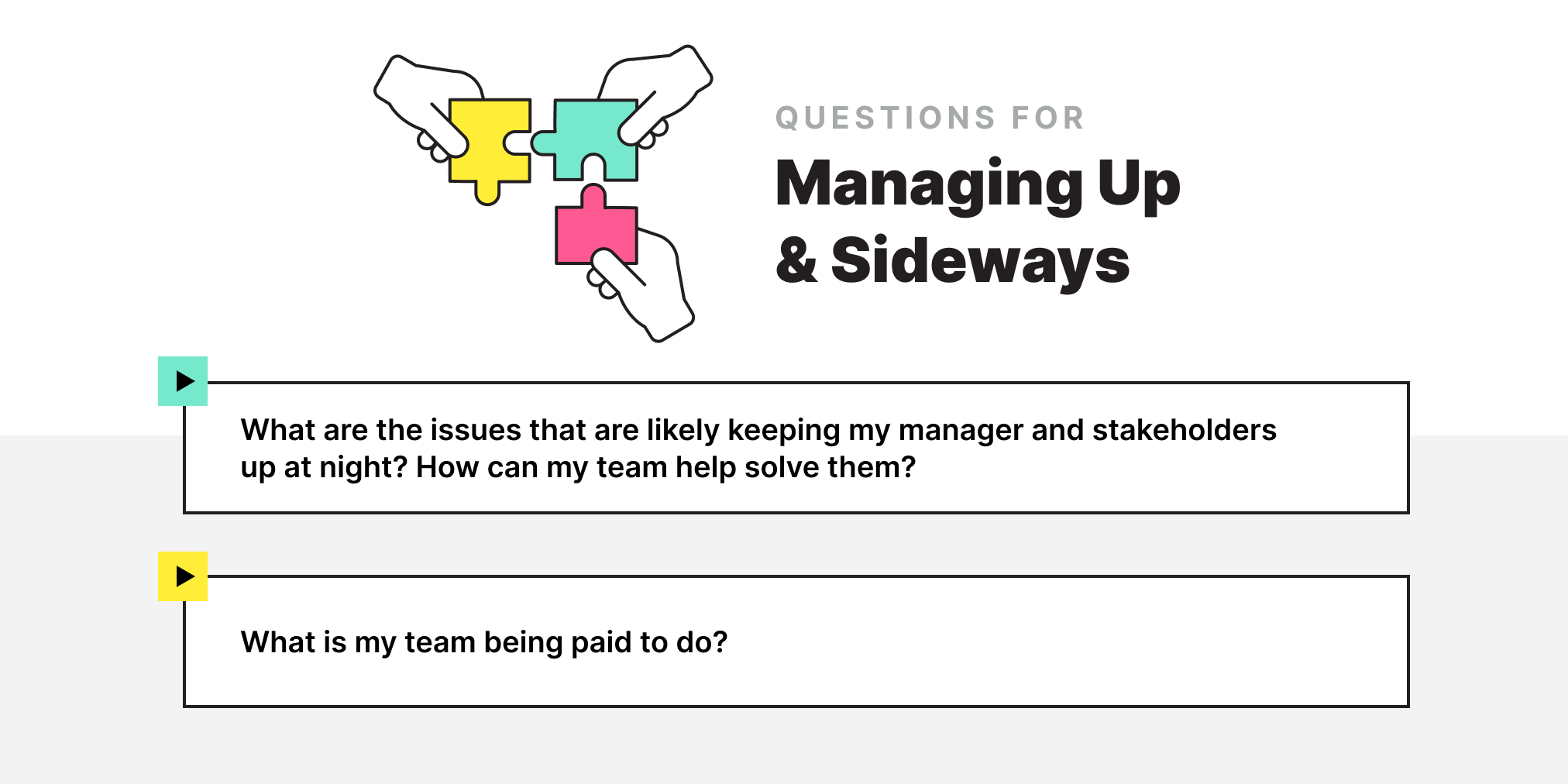
When you’re churning out work at a fast-paced startup, it’s easy to get stuck in the basement — so caught up in your own neverending to-do list that you lose track of what’s most important to your manager and cross-functional partners. Use these questions to manage up and sideways effectively, by staying closest to the problems the folks around you care about most.
25. Do I know what’s important to my boss right now?
The clearest path to creating a positive relationship with your manager is by tackling the problems that keep them up at night. That means frequent self-check-ins on how your weekly action items are lining up with the bottom line. Use these prompts from Sara Rosso as your guide:
- Is our work making an impact on my boss’s most important issues?
- How healthy and frequent is my communication with my boss?
- Am I showing enough visibility of the work my team is producing to the right people?
- Are we sharing our work at the highest level possible, at the earliest point possible and in a collaborative way?
- Are we getting honest and frequent feedback on that work?
26. What is my team being paid to do?
Johnathan Nightingale, co-founder of Raw Signal Group, suggests asking yourself this question every couple of months. “It's easy to fall fully into an operator mindset — fighting fires, refactoring, managing stakeholders, massaging timelines. That's important work that keeps everything running smoothly. But running smoothly for what? One possibility is that the answer to this question brings clarity to a leader and her team. That's a great outcome. But another great outcome is when the answer is, ‘I don't really know.’ Many leaders don't. And realizing that is the kick in the ass they need to go figure it out,” says Nightingale. (For more on upping your management game, check out the Raw Signal Group founder’s tactical read on creating better management training programs.)

These days even a small-to-medium-sized team can represent millions of dollars in spend. What does the organization think they're buying for that?
27. If the business were a person, would they significantly benefit from my organization’s priorities and efforts?
“I perform a retrospective like many organizations and teams, leveraging predefined quantitative and qualitative signals and metrics like org health, roadmap milestone progress and innovation goals. However, simply answering these questions can sometimes prevent a leader from identifying and driving the highest levels of potential impact,” says Howard Ekundayo, Director of Engineering at Netflix.
When asking himself the above question, he challenges himself and his teams to answer with a simple yes or no. “An answer of no often signals a need to think creatively, partner cross-functionally and engage senior leadership for more context to inform a strategic outlook on how to change the answer of this question to yes,” he says.
28. What have I been hesitating to share, create or take action on?
“As someone who’s been known to strive for perfection, it can be limiting. Perfectionism blocks access and awareness to our work and prevents us from quickly iterating in ways that could yield great results,” says Massela Dukuly. “One of our values at LifeLabs is that 80% is better than 0%. Don’t wait for perfection — be willing to share soon and often. Ask for feedback and get things in front of others. What we receive in return usually allows us to create a better end-product.”
29. What does the person on the other end need to know?
“At a fast-growing startup, I’ve noticed how much time gets wasted in trying to convey a message — whether I’m the messenger or the receiver. I try to evaluate what are the most essential elements that the person I’m communicating with really needs to know, and condense my message to those most essential points,” says Erica Lowe, Director of Production and Building for Steno.

30. How can I drive conversation across teams?
“We try to apply Drift’s company philosophy — everything starts with a conversation — to how we operate internally. Too often, organizations work in silos, and managers play an important role in helping different teams communicate with one another,” says Katie Foote, Chief Marketing Officer of Drift.
QUESTIONS FOR FOCUSING ON YOUR PERSONAL WELL-BEING

To show up for your team — whether you've got a 100-person org, or just a single direct report — you've got to keep yourself emotionally fit. When you're depleted or burnt out, use these questions to get back on track with your self-care.
31. What energized me today?
“Work is intense and emotional, and all the context switching you have to do can send you into a trance of being reactive,” says executive coach Alisa Cohn. She recommends setting a daily practice to jot down the answers to these questions:
- What energized me today?
- What drained me today?
- How am I feeling right now?
- Given all that, what should I do next?
“Sometimes the answer is to reconnect with one of your employees you had a rough interaction with. Sometimes you’ll see you need to finish a task you’ve been putting off, and sometimes the answer is to go outside for a quick walk. Or eat lunch. Tuning into yourself helps you course-correct the normal mood swings of day-to-day life — and it helps you choose a response, rather than have a reaction. As a manager, your team and your peers will thank you for this,” says Cohn.
32. Am I being kind to myself?
Nikita Miller, SVP of Product at The Knot, literally puts this question front-and-center — on a bright yellow sticky note on her computer monitor. “It's often easier to be caught up in the questions of what's best for our end-users, what's best for our business, how do I move this initiative forward? For highly ambitious and motivated individuals, it's often helpful to remember that a lot of what we do is about managing uncertainty. We don't have all the answers — and that's okay. Remember to be kind to yourself — and share this mantra with your employees, too,” she says.

33. What can I learn from this?
“When something doesn't go the way I thought it would or should, instead of blaming myself or others, I try to get very, very curious and look for the learning opportunities,” says First Round Partner Brett Berson. When he finds himself getting frustrated by a situation, he leans on these questions from CEO coach Jerry Colonna, who authored “Reboot: Leadership and the Art of Growing Up.”
- How have I been complicit in creating the conditions I say I don’t want?
- What am I not saying that needs to be said?
- What am I saying that’s not being heard?
- What’s being said that I’m not hearing?
34. Was I busy or productive today?
“In a startup environment, it’s easy to be very busy, but the real challenge is finding ways to be truly productive in your work,” says Lattice’s Brett Wienke. He suggests rigorously prioritizing your calendar and clarifying what can be removed that isn’t making progress towards one of your monthly, quarterly or fiscal goals.
35. What do I want to practice?
As kids, whether you practiced a sport, your multiplication tables or scales on your instrument, more often than not, we spent much more time practicing than actually performing. But once we enter the workforce, this notion of practice quickly evaporates.
This question from Robel Yemiru, Head of Product and Engineering Operations at Benchling, is an important reminder that career growth relies on practicing — whether you’re practicing a new tool that you haven’t quite mastered yet, or practicing a new technique for delivering feedback.
Try bringing this practice mentality to your whole team with this question from Monty Fowler: “What new skill are we working to build this month?”
Cover image by Getty Images / Maciej Toporowicz
